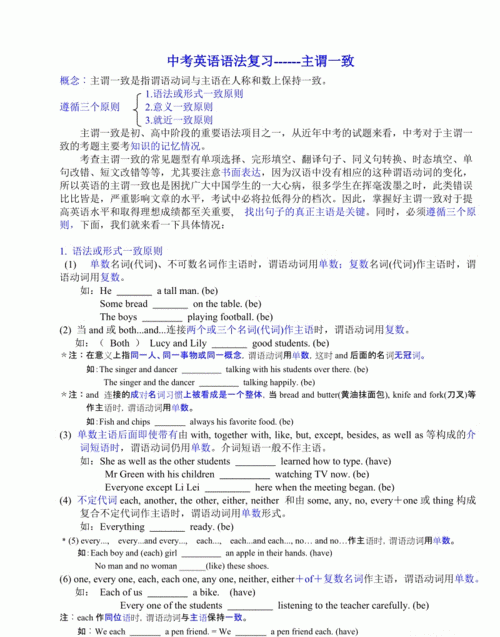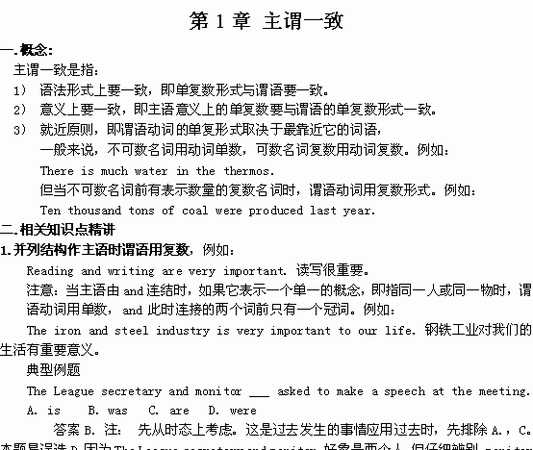本文目录
英语中的主谓一致性归纳
主谓一致的定义
主谓一致指的是主语和谓语在人称和数的方面取得一致的问题。
主语若是复数,谓语也采用复数形式。
主语若是单数或是不可数名词,谓语采用单数形式。
主谓一致的分类
主谓一致分为两大类:就近一致原则和意义一致原则。
就近一致原则指的是,以靠近谓语动词的,作主语的名词作为人称和数的参考标准。
意义一致原则指的是,必须分析主语属于单数或是复数,可数或是不可数,然后才能决定谓语动词的人称和数的形式。
就近一致原则(1)
连词not only...but also/ neither...nor/ or/ either...or/ not...but
<><><>
Not only the students but also the teacher is enjoying the film.
不仅学生而且老师都在津津乐道地看着电影。
Neither the students nor the teacher knows anything about it.
同学们和老师对此都一无所知。
Neither he nor they are wholly right.
他和他们,谁都不是完全对的。
Either he or I am right.
或者他对,或者我对。
就近一致原则(2)
副词here/ there
<><><>
Here comes the bus.
瞧,公共汽车来了。
Here is a pencil-box for you.
这儿有一个铅笔盒要给你。
Here are my replies to your questions.
这些是我针对你的问题的回答。
There is an apple, two bananas and some oranges on the plates.
盘子里有一个苹果,两条香蕉和一些桔子。
主谓一致:and
and的两边分别是不同的可数名词。
John and Mary are my friends.
约翰和玛丽都是我的朋友。
<><><>
and的两边分别是不同的不可数名词。
Both rice and wheat are grown in China.
中国有种水稻也有种小麦。
<><><>
and的两边的单词构成一个统一的概念。
Fish and chips is a popular supper here.
炸鱼土豆片在这里是一种很受欢迎的晚餐。(鱼和土豆片作为整体)
The poet and writer has come.
那位诗人兼作家来了。(同一个人既是诗人又是作家)
<><><>
each(every) + 单数名词 + and + each(every) + 单数名词
谓语动词用单数
Every hour and every minute is important.
每一小时,每一分钟,都很重要。
主谓一致:with...
“主语 + 后置定语”谓语动词只看主语,不看后置定语部分。
引起这种后置定语的单词有:
with, along with, together with, as well as, like, rather than, but,
except, besides, including, in addition to。
<><><>
The teacher with two students was at the meeting.
那位老师还有两个学生参加会议。
I as well as they am ready to help you.
不仅他们乐以帮助你,我也乐以帮助你。
A woman with two children is over there at the bus stop.
一个妇女还有两个孩子在公共汽车站那儿。
主谓一致:to do, doing
主语是由不定式、动名词、从句构成的,谓语动词采用单数。
To learn a foreign language is not easy.
It’s not easy to learn a foreign language.
学外语不容易。
Working with you is pleasant.
It’s pleasant working with you.
同你一块工作是令人愉快的。
The building whose roof we can see from here is a hotel.
我们从这儿就能看到屋顶的那座楼房就是旅馆。
主谓一致:police
police 警察/ militia民兵/ people人们/ vermin 害虫/ cattle 牲畜/ poultry 家禽
<><><>
这类集体名词的后面常接复数的谓语动词。
The police are questioning everyone in the house.
警察正在盘问房间里的每一个人。
Domestic cattle provide us with milk, beef, and hides.
家牛为我们提供牛奶、牛肉和皮革。
主谓一致:family
army军队/ data 数据/ jury 陪审团/ audience 观众/ enemy 敌人/ media 媒体
bacteria 细菌/ family 家庭/ navy 海军/ committee 委员会/ flock 羊群
nobility 贵族/ community 共同体/ firm 商号/ party 政党/ company 公司
gang 一群/ press 新闻界/ council 理事会/ government 政府/ public 公众
couple 对、双/ group 组/ staff 全体职员/ crew 全体人员/ herd 牧群/ team 队
<><><>
这类集体名词可以用作单数也可以用作复数。如果把"family"看成家庭成员,谓语用复数。如果把"family"看成一个整体,谓语用单数。
<><><>
His family are waiting for him.
他的家人正在等他。(把"family"看成家庭成员)
I've got to make it clear that my family was very poor.
我得说清楚,我的家是很穷的。(把"family"看成一个整体)
主谓一致:furniture
mankind 人类/ furniture 家具/ foliage 植物
clothing 衣服/ machinery 机械/ merchandise 货物
这类集体名词只能用作单数形式,因为它们属不可数名词。
<><><>
Our clothing protects us from cold.
衣服保护我们免受寒冻。
Then the furniture was moved in.
然后家具被搬进来。
主谓一致:trousers
glasses眼睛/ spectacles眼睛/ scissors剪刀/ shorts短裤/
trousers裤子/ pajamas睡衣
Where are my pajamas? 我的睡衣在哪里?
My trousers are too long. 我的裤子太长了。
<><><>
shoe鞋子/ glove手套/ sock袜子/
目前的教辅把shoes归入和trousers同一类,这样作对于高考没有大碍。不过两者的不同之处在以后的大学课堂中还需明辨。
主谓一致:the old
名词化的形容词作主语时要看主语的具体情况。
一. 看作复数
The wounded were sent home.
伤员被送回家。(指一批人,动词用复数。)
The old are taken good care of here.
这儿的老人受到很好的照顾。(一批人)
二. 看作单数
The true is to be distinguished from the false.
真假必须辨明。(抽象的概念,看成单数。)
The accused was punished to prison.
那个被告被判入狱。(一个人)
主谓一致:two years
时间、金钱、路程的名词
虽是用复数形式作主语,谓语动词仍然要用单数形式。
Two years is enough.
两年就够了。
A hundred miles is a long distance.
一百英里是一段很长的距离。
主谓一致:percent
分数和百分数的词作主语时,以“of 短语”中的名词为判断标准。
Thirty percent of the grain is used to feed animals.
百分之三十的粮食用来饲养牲口。
Ninety percent of the smokers are male.
百分之九十的吸烟者是男性。
主谓一致:each
以下列不定代词作主语的句子谓语动词用单数:
either, neither, each, one, the other, another, anybody, anyone, anything,
somebody, someone, something, everybody, everyone, everything, nobody,
no one, nothing(含有单数意义的不定代词)
<><><>
Neither of those men is wrong.
那两个人都没有错。
Each of the books costs ten dollars.
每一本书花费10美元。
Somebody is using the phone.
有人在用电话。

各位帮帮忙 主谓一致总结: .谓语动词只能用单数的有: 2谓语动词只能用复数的有:
看这篇能否帮上忙:
在英语句子里,谓语受主语支配,其动词必须和主语在人称和数上保持一致,这就叫主谓一致。寻其规律,大致可归纳为三个原则,即语法一致、逻辑意义一致和就近一致原则。
(一)语法一致原则:语法上一致就是谓语动词和主语在单、复数形式上保持一致。
1、以单数名词或代词、动词不定式短语、动名词短语或从句作主语时,谓语动词一般用单数形式;主语为复数时,谓语动词用复数形式。如:His father is working on the farm. / To study English well is not easy. / What he said is very important for us all. / The children were in the classroom two hours ago. / Reading in the sun is bad for your eyes.
注意:由what引导的主语从句,后面的谓语动词多数情况用单数形式,但若表语是复数或what从句是一个带有复数意义的并列结构时,主句的谓语动词用复数形式。如:What I bought were three English books. / What I say and do is (are) helpful to you.
2、由连接词and或both … and连接起来的合成主语后面,要用复数形式的谓语动词。如:Lucy and Lily are twins. / She and I are classmates. / The boy and the girl were surprised when they heard the news. / Both she and he are Young Pioneers.
注意:① 若and所连接的两个词是指同一个人或物时,它后面的谓语动词就应用单数形式。如:The writer and artist has come.; / ② 由and连接的并列单数主语前如果分别有no, each, every more than a (an) , many a (an)修饰时,其谓语动词要用单数形式。如:Every student and every teacher was in the room.. / No boy and no girl likes it.
3、主语为单数名词或代词,尽管后面跟有with, together with, except, but, like, as well as, rather than, more than, no less than, besides, including等引起的短语,谓语动词仍用单数形式;若主语为复数,谓语用复数形式。如:Mr Green, together with his wife and children, has come to China. / Nobody but Jim and Mike was on the playground. / She, like you and Tom, is very tall.
4、either, neither, each, every 或no +单数名词和由some, any, no, every构成的复合不定代词,都作单数看待。如:Each of us has a new book. / Everything around us is matter.
注意:① 在口语中当either或neither后跟有“of+复数名词(或代词)”作主语时,其谓语动词也可用复数。如:Neither of the texts is (are) interesting. ② 若none of后面的名词是不可数名词,它的谓语动词就要用单数;若它后面的名词是复数,它的谓语动词用单数或复数都可以。如:None of us has (have) been to America.
5、在定语从句时,关系代词that, who, which等作主语时,其谓语动词的数应与句中先行词的数一致。如:He is one of my friends who are working hard. / He is the only one of my friends who is working hard.
6、如果集体名词指的是整个集体,它的谓语动词用单数;如果它指集体的成员,其谓语动词就用复数形式。这些词有family, class, crowd, committee, population, audience等。如:Class Four is on the third floor. / Class Four are unable to agree upon a monitor.
注意:people, police, cattle等名词一般都用作复数。如:The police are looking for the lost child.
7、由“a lot of, lots of, plenty of, the rest of, the majority of + 名词”构成的短语以及由“分数或百分数+名词”构成的短语作主语,其谓语动词的数要根据短语中后面名词的数而定。如:There are a lot of people in the classroom. / The rest of the lecture is wonderful. / 50% of the students in our class are girls.
注意: a number of“许多”,作定语修饰复数名词,谓语用复数;the number of“…的数量”,主语是number,谓语用单数。
8、在倒装句中,谓语动词的数应与其后的主语一致。如:There comes the bus./ On the wall are many pictures. / Such is the result. / Such are the facts.
(二)逻辑意义一致原则:逻辑意义一致就是谓语动词的数必须和主语的意义一致(因有时主语形式为单数,但意义为复数;有时形式为复数,但意义为单数)。
1、what, who, which, any, more, all等代词可以是单数,也可是复数,主要靠意思来决定。如:Which is your bag? / Which are your bags? / All is going well. / All have gone to Beijing.
2、表示“时间、重量、长度、价值”等的名词的复数作主语时,谓语动词通常用单数形式, 这是由于作主语的名词在概念上是一个整体,如:Thirty minutes is enough for the work.
3、若英语是书名、片名、格言、剧名、报名、国名等的复数形式,其谓语动词通常用单数形式。如: “The Arabian Nights”is an interesting story-book.
4、表数量的短语“one and a half”后接复数名词作主语时,其谓语动词可用单数形式(也可用复数。如:One and a half apples is (are) left on the table.
5、算式中表示数目(字)的主语通常作单数看待,其谓语动词采用单数形式。如:Twelve plus eight is twenty. / Fifty-six divided by eight is seven.
6、一些学科名词是以 –ics 结尾,如:mathematics, politics, physics 以及news, works等,都属于形式上是复数的名词,实际意义为单数名词,它们作主语时,其谓语动词要用单数形式。如:The paper works was built in 1990. / I think physics isn’t easy to study.
7、trousers, glasses, clothes, shoes, 等词作主语时,谓语用复数,但如果这些名词前有a (the) pair of等量词修饰时,谓语动词用单数。如:My glasses are broken. / The pair of shoes under the bed is his.
8、“定冠词the + 形容词或分词”,表示某一类人时,动词用复数。
(三)就近一致原则:在英语句子中,有时谓语动词的人称和数与最近的主语保持一致。
1、当两个主语由either … or, neither … nor, whether … or …, not only … but also连接时,谓语动词和邻近的主语一致。如:Either the teacher or the students are our friends. / Neither they nor he is wholly right. / Is neither he nor they wholly right?
2、there be句型be动词单复数取决于其后的主语。如果其后是由and连接的两个主语,则应与靠近的那个主语保持一致。如:There are two chairs and a desk in the room..
注意:Here引导的句子用法同上。

主谓一致语法总结思维导图
主谓一致有三种一致原则,即:
一. 语法一致;
二. 概念一致(语言内容上一致);
三. 相邻一致(就近原则)。
具体讲解:
一. 语法一致;
1、单数主语、单个动词不定式、动名词短语以及句子做主语,谓语动词要用单数形式。复数主语,用and或both…and连接的动词不定式短语、动名词短语以及主语从句作主语,谓语动词则用复数形式。例如:
Serving the people is my great happiness.
为人民服务是我最大的幸福。
Whether we’ll go depends on the weather.
我们是否去要取决于天气的好坏。
2、当如下词或短语,如:
as well as/with/along with/like/ together with/ rather than/except but/including/
accompanied by/ plus/besides/in addition to/no less than 等引起的结构跟在主语后
面,不能看作是并列主语,该主语不受这些词组引导的插入语的影响,主语如是单数,其谓语动词仍然用单数形式。
The reading course book, plus its reference books, is helpful to college students.
教材加上参考书对大学学生是非常有益的。
The man together with his wife and children sits on the sofa watching TV.
那个人和他妻儿老小坐在沙发上看电视。
3、有些代词只能指单数可数名词,当它们在句子中做主语时,尽管在意义上是多数,谓语动词仍要用单数形式。这类代词有:
either, neither, each one, the other ,another,somebody ,someone, something,anyone, anything, anybody,everyone, everything, everybody,no one, nothing ,nobody; 例如:
Neither likes the friends of the other.
两人都不喜欢对方的朋友。
Everything around us is matter.
我们周围的所有东西都是物质。
4、当and连结的两个名词是指同一个人或同一件事,and后的名词前没有冠词,谓语动词应该用单数形式;在and后面的名词前有冠词,谓语就用复数形式。例如:
The bread and butter is served for breakfast. 早饭供应黄油面包。
The bread and the butter are on sale. 正在出售黄油和面包。
5、当one of, a portion of, a series of, a species of, a chain of 结构作主语时,谓语动词要用单数形式。例如:
One of those students has passed the examination.
这些学生只有一个考试及格了。
A series of pre-recorded tapes has been prepared for language laboratory use.
为语音课提前准备了一系列录音磁带。
6、由one and a half + 复数名词或the majority of + 名词做主语时,谓语动词视名词的单复数形式而定。例如:
The majority of the damage is easy to repair.
大部分的损坏品都容易修理。
One and a half students are reading English.
大部分学生在读英语。
7、plenty of, half of, a lot of, lots of, heaps of, loads of, scads of等 + 可数与不可数名词做主语时,不可数名词的谓语只用单数,可数名词的谓语视可数名词的单复数而定。例如:
There is plenty of water in the pail.
桶里还有好多水。
There are plenty of eggs in the box.
箱子里有好多鸡蛋。
8、由more than one (或more than one + 单数名词),many a + 单数名词做主语,谓语动词要用单数形式。例如:
More than one student has passed the examination.
不止一个学生通过了这次考试。
Many a boy learns to swim before he can read.
许多孩子在认字前就学会了游泳。
9、如果名词词组中心词是“分数或百分数 + of + 名词”,谓语动词的单、复数形式取决于of后的名词或代词的单、复数形式。例如:
Over three-quarters of the land has been reclaimed.
四分之三多的土地已经收回了。
Two-thirds of the people present are against the plan.
到场的三分之二的人都反对这个计划。
10、定语从句谓语动词的单复数形式应与先行词一致。例如:
He is one of the men who were chosen to represent the group.
被选出来代表该组的人他是其中之一。
“Keep cool” is the first of the rules that are to be remembered in an accident.
“镇静”是事故发生时应当牢记的第一条原则。
二. 概念一致原则:
1、有些集合名词如crowd, family, team, group, government, committee, class, school, union, firm, staff, public等,它们做主语时,谓语动词的数要根据语言内容而定。如果它们作为一个集体单位时,动词用单数形式,如就其中的各个成员来说,则谓语用复数形式。例如:
His family is going to move.
他准备搬家。
His family are very well.
他家人身体都好。
2、有些表示总体意义的名词,形式上是单数,而意义上却是复数,谓语动词要用复数形式,如people, police, militia, cattle, poultry等。例如:
The police are searching for a tall dark man with a beard.
警察正在搜寻一位肤色黝黑、长胡子的高个子男人。
3、有些名词形式上是复数,而意义上却是单数。如news, means, works.还有许多以-ics结尾的学科名称,如economics, physics, mechanics, politics等,它们做主语时,谓语动词要用单数形式。例如:
Politics is a complicated business.
政治学是一门复杂的东西。
Here is the news.
下面播送新闻。
4、用and连接的单数主语,前面有each, every, many a, no等修饰时,谓语动词要用单数形式。复数主语与each连用时,应不受each的影响,谓语动词仍用复数形式。例如:
Every boy and girl is treated in the same way.
每个男孩、女孩都是以同样的方式对待的。
Many a boy and many a girl has seen it.
很多姑娘小伙子都见过。
The old workers and the young each have their own tools.
青老年工人都各自有自己的工具。
5、表示重量、度量、衡量、价值的复数名词做主语,谓语动词常用单数形式。例如:
Twenty miles is a long way to walk.
二十里地可是个不近的路程。
Three pints isn’t enough to get me drunk.
三品脱还不至于把我灌醉。
6、the +形容词作主语时,如主语指的是一类人,谓语动词用复数形式;如果指的是单个人或抽象概念,谓语动词用单数形式。例如:
The departed was a good friend of his.
离开者是他的一位好友。
The old are playing Beijing Opera there.
老人们正在那表演京剧。
三. 就近原则:
相邻一致是指谓语动词的人称和数常常与最近作主语的词语保持一致.常出现在这类句子中的连词有:or, either… or …,neither… nor …,not only… but also …等.例如:
Either I or they are responsible for the result of the matter.
不是我,就是他们要对那件事的结局负责任.
Neither the unkind words nor the unfriendly attitude has caused me any distress.既不是那些不友好的话,也不是那不友好的态度让我沮丧.
Not only he but also all his family are keen on concerts.
不仅仅是他,而且是他全家人都很热衷于音乐会.
Neither his family nor he knows anything about it.
他全家人和他都不知道那件事.
注意:谓语动词用复数:
1、复数主语,用and或both…and连接
2、形式上是单数,实际表示复数意思
谓语动词用单数
1. 单数主语、单个动词不定式、动名词短语以及句子做主语
2. 形式上是复数,实际上是单数neither, everything
3. one of, a portion of, a series of, a species of, a chain of 结构作主语

英语中分数的主谓一致
因为在第1个句子中,crops是“作物”的意思,是一个不可数的名词,所以用has,而第2个句子,friends是“朋友”的意思,是一个可数名词,所以用have。
解析:
分数做主语时 ,谓语动词根据分数后的名词决定单复数,若是可数名词就用复数形式,若是不可数名词就用单数形式(即分数/百分数 +of +名词作主语,谓语动词要和of之后的名词保持一致)。
在第1个句子Two thirds of the crops has been damaged by the storm.(意思:在暴风雪中,地里的三分之二的作物都已被毁坏了)中,crops是“作物”的意思,是一个不可数的名词,所以谓语动词要用has。
在第2个句子中Two thirds of my frends have been abroad.(我三分之二的朋友都已经出国了)中,friends是“朋友”的意思,是一个可数名词,所以谓语动词要用have。

关于主谓一致:
主谓一致指谓语动词在人称和数上要和主语保持一致,即主语的人称和单复数形式决定着对应的谓语动词的单复数形式。
主谓一致包括语法一致、就近一致、意义一致和其他特殊情况:语法一致即谓语动词在单复数形式上要和主语保持一致;就近一致就是谓语动词要和靠近它的主语部分保持一致;意义一致就是谓语动词要和主语意义上的单复数保持一致。
以上就是关于主谓一致语法总结英语 ,英语中的主谓一致性归纳的全部内容,以及主谓一致语法总结英语 的相关内容,希望能够帮到您。
